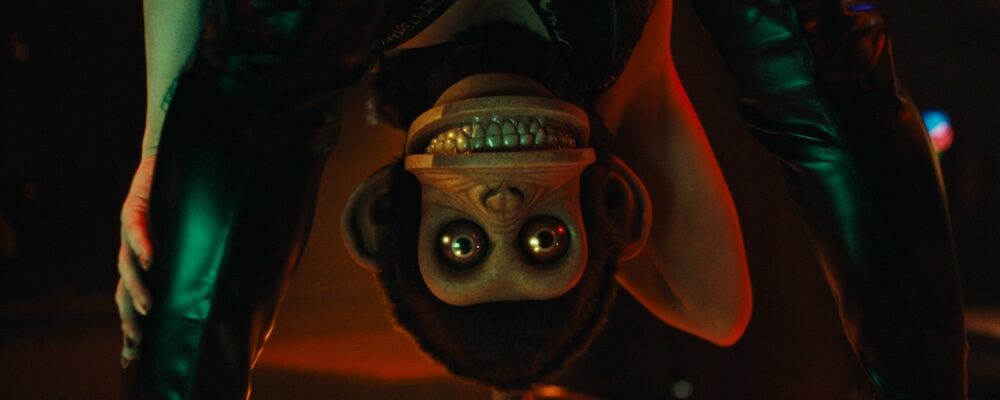‘The Monkey’: Osgood Perkins Adapts a Stephen King Story Into a Morbid Mocking of Mortality
Alci Rengifo
Laughing at mortality is a natural part of the horror experience. There’s a human appeal to the genre that can feel cathartic. Osgood Perkins’ “The Monkey” combines gore and humor to create a morbid experience that explores the inevitability of death. The source material is a short story by Stephen King, though the screenplay by Perkins barely follows it. King’s tale is an eerie little fable about fathers and sons and generational trauma passed through a strange object. This movie is a complete reimagining that prefers B-movie gags bordering on slapstick. Morbid laughs can work, and Perkins gets in a few memorable ones even if he sometimes lets the story lose focus and go off the rails.
Perkins’ take on the story begins with a desperate man (Adam Scott) trying to pawn off a toy monkey with a chilling grin and tin drum. Instantly we can see this item comes with some sort of deadly curse that results in gruesome deaths. Years later the twins, Hal and Bill Shelburne (Christian Convery), discover the toy monkey and wind it up, resulting in a tragic end for their babysitter. They conclude this toy is some kind of supernatural killer. You wind it up and someone dies. The ultimate tragedy occurs when their mother, Lois (Tatiana Maslany), drops dead from a ruptured brain aneurysm in the kitchen of their home. Cut to the present and adults Hal and Bill (Theo James) are no longer speaking. Hal is stuck in a rut, working at a grocery store and feeling alienated from his teen son, Petey (Colin O’Brien). He has purposefully kept his son at a distance to keep him from the monkey’s curse. When the accursed toy reappears, Hal has to reconnect with his brother and see if they can finally put this evil to rest.
Readers of the King story, which can be found in his excellent 1985 “Skeleton Crew” collection, are by now scratching their heads. The short story is closer to his famous “It,” crisscrossing between the past and present to capture how the trauma of the past impacts a life’s development. What makes Perkins’ version intriguing is how, like all his work thus far, it remains quite personal. “The Monkey” is the follow up to his hit from last year, “Longlegs,” with a memorably Satanic Nicolas Cage. Like that movie, there are biographical shadows in the narrative. Perkins is the son of actor Anthony Perkins, most famous for “Psycho,” and suffered the tragedy of losing his mother, Berry Berenson, who was one of the passengers on American Airlines Flight 11 in the 9/11 attacks. Sudden tragedy stalks “The Monkey” with a carnival feel. It drops in from ceilings, shotguns hidden in closets and gruesome moments like someone’s intestines being pulled out like measuring tape. Shot with atmosphere by Nico Aguilar, this movie still avoids becoming exploitative. There is almost a wink to the violence akin to medieval satire, like a scene involving an electrified swimming pool. Viscera explodes on the screen in moments daring us to laugh at just how fragile the human body is.
That spirit is necessary considering the actual plot of “The Monkey” would be left struggling for air without the tone and cast. By discarding King’s original structure, Perkins creates a plot that never seems to find any real answers or logic to itself. What’s behind the monkey’s malevolent force? When a human “villain” is finally revealed, his scheme is too absurd even for this movie. Yet, there is real pain in sincere moments, most of them in the first act. Tatiana Maslany is memorable as the cynical mom who drinks and tells her young sons about the futility of love. She’s not bad, just wounded by life and her end is equally tragic. That’s how it works out sometimes. Even as the violence and plot get convoluted, with a few deaths that truly become more ridiculous than amusing, an idea shines through about mortality forgiving no one, and how sometimes we convince ourselves of curses that are not there. Death is as inevitable as heartbreak. We just desperately seek excuses to banish away the harsher truth.
In this film, Perkins, who tends to be a somber filmmaker, splashes around random images that feel like surreal playfulness, at times without real direction as to why they are there. A squad of cheerleaders in a small town appears cheering amid carnage for no discernable reason. An apparent apocalypse takes place leaving us wondering if it is part of the narrative or a statement by Perkins on how everything will die. It’s a close call but there is a watchable energy to “The Monkey,” purposefully dabbling in schlock. Instead of getting overly pretentious, Perkins sets out to have twisted fun. He’s giggling at the very idea of the title’s namesake, presenting characters who are essentially losers. Stephen King has always been great at writing those, because they can be so relatable. Theo James is effective playing twins, Hal as the tamer, deadbeat and Bill as the one who grew up to be resentful and a bit insane. Bill blames Hal for their mother’s death since he happened to wind up that monkey that day. It sounds absurd but such conflicts sustain intrigue for most of the running time of “The Monkey.” It may not be Perkins’ best, yet it isn’t thoughtless. In these dark times, sometimes all we can do is laugh at the carnage.
“The Monkey” releases Feb. 21 in theaters nationwide.

